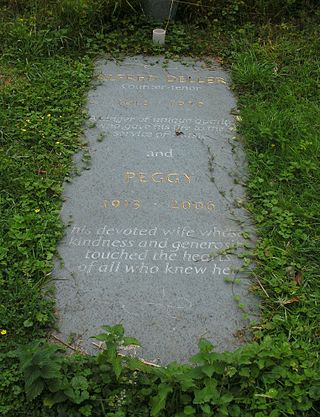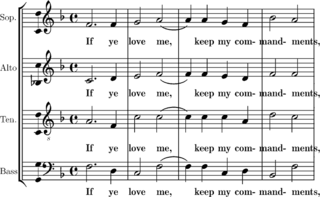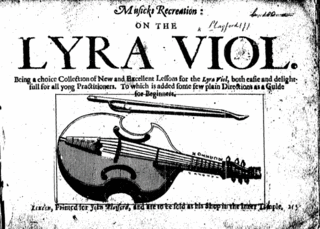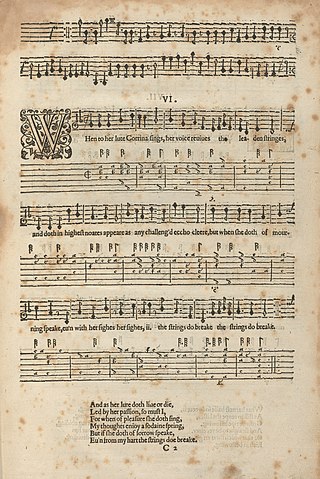Related Research Articles

The viol, viola da gamba, or informally gamba, is any one of a family of bowed, fretted, and stringed instruments with hollow wooden bodies and pegboxes where the tension on the strings can be increased or decreased to adjust the pitch of each of the strings. Frets on the viol are usually made of gut, tied on the fingerboard around the instrument's neck, to enable the performer to stop the strings more cleanly. Frets improve consistency of intonation and lend the stopped notes a tone that better matches the open strings. Viols first appeared in Spain and Italy in the mid-to-late 15th century, and were most popular in the Renaissance and Baroque (1600–1750) periods. Early ancestors include the Arabic rebab and the medieval European vielle, but later, more direct possible ancestors include the Venetian viole and the 15th- and 16th-century Spanish vihuela, a six-course plucked instrument tuned like a lute that looked like but was quite distinct from the four-course guitar.

Alfred George Deller, CBE, was an English singer and one of the main figures in popularising the return of the countertenor voice in Renaissance and Baroque music during the 20th century.

William Lawes was an English composer and musician.

A soprano clarinet is a clarinet that is higher in register than the basset horn or alto clarinet. The unmodified word clarinet usually refers to the B♭ clarinet, which is by far the most common type. The term soprano also applies to the clarinets in A and C, and even the low G clarinet—rare in Western music but popular in the folk music of Turkey—which sounds a whole tone lower than the A. While some writers reserve a separate category of sopranino clarinets for the E♭ and D clarinets, those are generally regarded as soprano clarinets as well. All have a written range from the E below middle C to about the C three octaves above middle C, with the sounding pitches determined by the particular instrument's transposition.

A consort of instruments was a phrase used in England during the 16th and 17th centuries to indicate an instrumental ensemble. These could consist of the same or a variety of instruments. Consort music enjoyed considerable popularity at court and in the households of the wealthy in the Elizabethan era, and many pieces were written for consorts by the major composers of the period. In the Baroque era, consort music was absorbed into chamber music.
The lirone is the bass member of the lira family of instruments that was popular in the late 16th and early 17th centuries. It is a bowed string instrument with between 9 and 16 gut strings and a fretted neck. When played, it is held between the legs in the manner of a cello or viol.

In music, homophony is a texture in which a primary part is supported by one or more additional strands that provide the harmony. One melody predominates while the other parts play either single notes or an elaborate accompaniment. This differentiation of roles contrasts with equal-voice polyphony and monophony. Historically, homophony and its differentiated roles for parts emerged in tandem with tonality, which gave distinct harmonic functions to the soprano, bass and inner voices.
Alfonso Ferrabosco the younger was an English composer and viol player of Italian descent. He straddles the line between the Renaissance and Baroque eras.
Thomas Lupo was an English composer and viol player of the late Elizabethan and Jacobean eras. Along with Orlando Gibbons, John Coprario, and Alfonso Ferrabosco, he was one of the principal developers of the repertory for viol consort.

The lyra viol is a small bass viol, used primarily in England in the seventeenth century.

Philip Rosseter was an English composer and musician, as well as a theatrical manager. His family seems to have been from Somerset or Lincolnshire, he may have been employed with the Countess of Sussex by 1596, and he was living in London by 1598. In 1604 Rosseter was appointed a court lutenist for James I of England, a position he held until his death in 1623. Rosseter is best known for A Book of Ayres which was written with Thomas Campion and published in 1601. Some literary critics have held that Campion wrote the poems for Rosseter's songs; however, this seems not to be the case. It is likely that Campion was the author of the book's preface, which criticizes complex counterpoint and "intricate" harmonies that leave the words inaudible. The two men had a close professional and personal relationship; when Campion died in 1620, he had named Rosseter his sole heir.
Francesco Rasi was an Italian composer, singer (tenor), chitarrone player, and poet.
Viola bastarda refers to a highly virtuosic style of composition or extemporaneous performance, as well as to the altered viols created to maximize players' ability to play in this style. In the viola bastarda style, a polyphonic composition is reduced to a single line, while maintaining the same range as the original, and adding divisions, improvisations, and new counterpoint. The style flourished in Italy in the late 16th and early 17th centuries. Francesco Rognoni, a prominent composer of divisions, stated that although works using the bastarda techniques could be played by a number of instruments, including organ, lute, and harp, the "queen" of bastarda technique was the viol because of its agility and large range.
Francesco Rognoni [of] Taeggio was an Italian composer. He was the son of Riccardo Rognoni and brother of Giovanni Domenico Rognoni Taeggio, both prominent Italian composers and musicians. He was active in Milan, but had connections with royalty from as far abroad as Archduke Charles of Austria, and King Sigismund III Vasa of Poland. Rognoni was a Papal Knight and hereditary Palatine Count. He published both collections of his works and treatises. His most famous work was Selva de varii passaggi, on both vocal and violin technique, and on how to ornament.

In a string instrument, the sound post or soundpost is a dowel inside the instrument under the treble end of the bridge, spanning the space between the top and back plates and held in place by friction. It serves as a structural support for an archtop instrument, transfers sound from the top plate to the back plate and alters the tone of the instrument by changing the vibrational modes of the plates.
Leonora Duarte was a Flemish composer and musician, born in Antwerp. She belonged to a wealthy Portuguese-Jewish family who were Converso, meaning they outwardly acted as Catholics while secretly maintaining their Jewish faith and practices. She was baptized on 28 July 1610.
Claudia Francesca Rusca was an Italian composer, singer, and organist.

The lira da braccio was a European bowed string instrument of the Renaissance. It was used by Italian poet-musicians in court in the 15th and 16th centuries to accompany their improvised recitations of lyric and narrative poetry. It is most closely related to the medieval fiddle, or vielle, and like the vielle had a leaf-shaped pegbox with frontal pegs. Fiddles with drone strings are seen beginning in the 9th century, and the instrument continued to develop through the 16th century. In many depictions of the instrument, it is being played by mythological characters, frequently members of angel consorts, and most often by Orpheus and Apollo. The lira da braccio was occasionally used in ensembles, particularly in the intermedi, and may have acted as a proto-continuo instrument.
The Buffet family was a family of French musical instrument makers.
Heinrich Traxdorf was an early German organ builder. He was born in Mainz, probably in the beginning of the 15th century. During the 1440s he built three organs in Nuremberg and one in Salzburg, for St. Peter's abbey church. Traxdorf was a progressive builder, one of the first to depart from the gothic organ model by dividing the Blockwerk into independent divisions, dividing the chests and separating the front stops into Flute (Principal) and Octave. The instruments had a single manual and pedal, whose ranges were B to d" (manual) and A to b (pedal).
References
- ↑ Hawkins, John (1776). A General History Of The Science and Practice Of Music: In Five Volumes, Volume 4, p.339-40. Payne.
- 1 2 Taruskin, Richard (2009). Music in the Seventeenth and Eighteenth Centuries:The Oxford History of Western Music. ISBN 9780199796038. Cites Thomas Mace.
- ↑ H. G. Bonavia Hunt (2005). A Concise History of Music From the Commencement of the Christian Era to the Present Time, p.142. ISBN 9781417906451.
- ↑ Busby, Thomas (1827). A Dictionary Music: Theoretical and Practical, p.55. Richard Phillips and Company.
- 1 2 Howard Meyer Brown and Ian Woodfield. "Chest of viols", Grove Music Online , ed. L. Macy (accessed November 4, 2006), grovemusic.com Archived 2008-05-16 at the Wayback Machine (subscription access).
- ↑ Christina Bashford. "Chamber music, §3: 17th and 18th centuries (i) 1600–1740.", Grove Music Online , ed. L. Macy (accessed November 4, 2006), grovemusic.com Archived 2008-05-16 at the Wayback Machine (subscription access).
- ↑ Fletcher, Alan J. Drama, Performance, and Polity in Pre-Cromwellian Ireland. University of Toronto Press, Toronto, 2000. ISBN 0-8020-4377-1.
- ↑ Eliasen, Alan. "Frink" (accessed June 15, 2010)